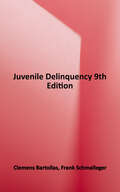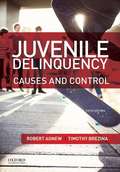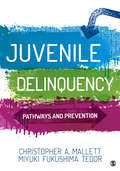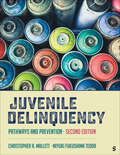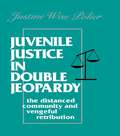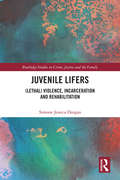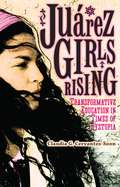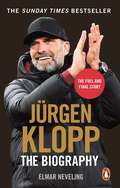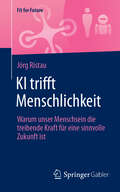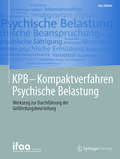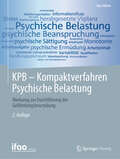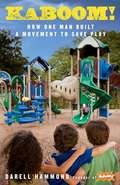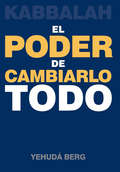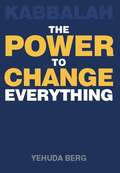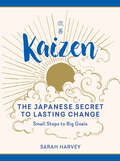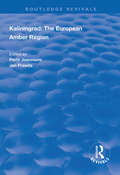- Table View
- List View
Juvenile Delinquency 9th Edition
by Frank Schmalleger Clemens BartollasA sociological exploration of the causes and consequences of delinquent behavior. Juvenile Delinquency, Ninth Edition, explores what delinquency is, its causes and influences, and strategies for delinquency prevention. Beyond simply analyzing the problems of delinquency in American society, the authors also examine what can be done about delinquent behavior. The text follows a strong sociological focus and discusses how delinquency develops across a life course, including how it begins, persists, and/or how it terminates in the lives of individuals. The text is unified by the theme of delinquency prevention and offers evidence-based policy recommendations and suggestions for possible treatment interventions.
Juvenile Delinquency in an English Middle Town (International Library of Sociology #No. 109)
by Hermann MannheimFirst published in 1998. Routledge is an imprint of Taylor & Francis, an informa company.
Juvenile Delinquency: Causes and Control (Fifth Edition)
by Robert Agnew Timothy BrezinaAn essential resource for exploring juvenile delinquency in the twenty-first century, Juvenile Delinquency: Causes and Control, Fifth Edition, offers a clear and concise overview of the latest theories and research on the causes and control of delinquency. Instead of attempting to provide a sweeping view of the entire subject, Robert Agnew and new coauthor Timothy Brezina organize the text around three major questions: What is the nature and extent of delinquency? What are the causes of delinquency? What strategies should we employ to control delinquency? These thought-provoking questions draw students into the text, challenging them to use major theories to explain the basic facts about delinquency, to understand the research on its causes, and to develop and evaluate programs and policies for its control.
Juvenile Delinquency: Pathways and Prevention
by Christopher A. Mallett Miyuki Fukushima Tedor"This textbook is an excellent tool that explores issues impacting juvenile delinquency, theories, system response, community interventions, and effective programs to help reduce delinquency." —Robbin Day Brooks, MSW, CPP, Arizona State University’s School of Criminology & Criminal Justice Juvenile Delinquency: Pathways and Prevention explores the pivotal roles that family, trauma, mental health, and schools have on juvenile delinquency, while exploring opportunities for prevention and intervention. Authors Christopher A. Mallett and Miyuki Fukushima Tedor draw from years of experience working with juvenile offenders to shed light on the nature of delinquency and the diverse pathways to juvenile delinquency, while offering evidence-based techniques for preventing and rehabilitating youthful offenders. Clear explanations of the concepts and thought-provoking case studies move students beyond memorization—encouraging them to think critically about juvenile delinquency and make recommendations for better practices and policies. Give your students the SAGE edge! SAGE edge offers a robust online environment featuring an impressive array of free tools and resources for review, study, and further exploration, keeping both instructors and students on the cutting edge of teaching and learning.
Juvenile Delinquency: Pathways and Prevention
by Christopher A. Mallett Miyuki Fukushima Tedor"This textbook is an excellent tool that explores issues impacting juvenile delinquency, theories, system response, community interventions, and effective programs to help reduce delinquency." —Robbin Day Brooks, MSW, CPP, Arizona State University’s School of Criminology & Criminal Justice Juvenile Delinquency: Pathways and Prevention explores the pivotal roles that family, trauma, mental health, and schools have on juvenile delinquency, while exploring opportunities for prevention and intervention. Authors Christopher A. Mallett and Miyuki Fukushima Tedor draw from years of experience working with juvenile offenders to shed light on the nature of delinquency and the diverse pathways to juvenile delinquency, while offering evidence-based techniques for preventing and rehabilitating youthful offenders. Clear explanations of the concepts and thought-provoking case studies move students beyond memorization—encouraging them to think critically about juvenile delinquency and make recommendations for better practices and policies. Give your students the SAGE edge! SAGE edge offers a robust online environment featuring an impressive array of free tools and resources for review, study, and further exploration, keeping both instructors and students on the cutting edge of teaching and learning.
Juvenile Delinquency: Pathways and Prevention
by Christopher A. Mallett Miyuki Fukushima TedorJuvenile Delinquency: Pathways and Prevention, Second Edition explores the pivotal roles that family, trauma, mental health, and schools have on juvenile delinquency, while examining opportunities for prevention and intervention. Authors Christopher A. Mallett and Miyuki Fukushima Tedor draw from years of experience working with juvenile offenders to shed light on the nature of delinquency and the diverse pathways to juvenile delinquency, while offering evidence-based techniques for preventing and rehabilitating youthful offenders. Each chapter features interactive and critical thinking sections alongside special interest boxed features, designed to move students beyond memorization while guiding them to develop informed recommendations for better practices and policies.
Juvenile Delinquency: Pathways and Prevention
by Christopher A. Mallett Miyuki Fukushima TedorJuvenile Delinquency: Pathways and Prevention, Second Edition explores the pivotal roles that family, trauma, mental health, and schools have on juvenile delinquency, while examining opportunities for prevention and intervention. Authors Christopher A. Mallett and Miyuki Fukushima Tedor draw from years of experience working with juvenile offenders to shed light on the nature of delinquency and the diverse pathways to juvenile delinquency, while offering evidence-based techniques for preventing and rehabilitating youthful offenders. Each chapter features interactive and critical thinking sections alongside special interest boxed features, designed to move students beyond memorization while guiding them to develop informed recommendations for better practices and policies.
Juvenile Justice in Britain and the United States: The Balance of Needs and Rights (Routledge Revivals Ser.)
by Phyllida ParsloeThis study, first published in 1978, compares the ways in which the systems in England, Scotland and the United States balance the necessity of meeting children‘s needs against the protection of their rights. Three approaches to juvenile justice are identified; the criminal justice, the welfare, and the community approach. This book will be of interest to students of sociology, criminology and social work.
Juvenile Justice in Double Jeopardy: The Distanced Community and Vengeful Retribution
by The Honorable PolierThroughout her entire career, Judge Polier continually fought for the rights and needs of the poor. In this volume she describes the granting and denial of justice toward the poor -- particluarly poor children -- she observed during her tenure as a Family Court Judge in New York City. The book discusses the current state of the justice system and the outlook for the future. This volume helps readers understand how broadly shared the responsibility for the neglect of today's youth is and how society must reshape its attitudes and realign its priorities to help the thousands of children who are dependent upon the public for care and support. The book identifies how the courts have been weakened by their loss of direct contact with delinquent and neglected children and the "need for humanity and respect in dealing with difficult human problems." (from the introduction). From her personal experiences and observations, Judge Polier describes the granting and denial of justice she observed while she consistently emphasizes the need for direct contact with delinquent and neglected children. For students, professional, and researchers in sociology, criminal justice, and any social science discipline dealing with children and children's problems, Polier's book provides a behind-the-scenes look at one of the major problems facing society today.
Juvenile Lifers: (Lethal) Violence, Incarceration and Rehabilitation (Routledge Studies in Crime, Justice and the Family)
by Simone DeeganThis book is the first Australian study, based on extensive fieldwork, of the personal backgrounds and processes by which juveniles get drawn into risky and violent situations that culminate in murder. Drawing on interviews with every juvenile under sanction of life imprisonment in the State of South Australia (2015–2019), it investigates links in the chain of events that led to the lethal violence that probably would have been broken had there been appropriate intervention. Specifically, the book asks whether the existing criminal justice frame is the appropriate way to deal with children who commit grave acts. The extent to which prison facilitates and/or inhibits the mental, emotional, and social development of juvenile ‘lifers’ is a critical issue. Most – if not all – will be released at some point, with key issues of risk (public protection) and rehabilitation (probability of desistance) coming sharply to the fore. In addition, this book is also the first to capture how significant others including mothers, fathers, grandparents, and siblings are affected when children kill and the level of commitment these relatives have towards supporting the prisoner in his or her quest to build a positive future. Written in a clear and direct style, this book will appeal to students and scholars of criminology, sociology, andpenology; practitioners working in social policy; and all those interested in the lives and backgrounds of juvenile offenders.
Juárez Girls Rising: Transformative Education in Times of Dystopia
by Claudia G. Cervantes-SoonWorking-class girls in Ciudad Juárez grow up in a context marked by violence against women, the devastating effects of drug cartel wars, unresponsive and abusive authorities, and predatory U.S. capitalism: under constantly precarious conditions, these girls are often struggling to shape their lives and realize their aspirations. Juárez native Claudia G. Cervantes-Soon explores the vital role that transformative secondary education can play in promoting self-empowerment and a spirit of resistance to the violence and social injustice these girls encounter.Bringing together the voices of ten female students at Preparatoria Altavista, an innovative urban high school founded in 1968 on social justice principles, Cervantes-Soon offers a nuanced analysis of how students and their teachers together enact a transformative educational philosophy that promotes learning, self-authorship, and hope. Altavista&’s curriculum is guided by the concept of autogestión, a holistic and dialectical approach to individual and collective identity formation rooted in the students&’ experiences and a critical understanding of their social realities. Through its sensitive ethnography, this book shows how female students actively construct their own meaning of autogestión by making choices that they consider liberating and empowering.Juárez Girls Rising provides an alternative narrative to popular and often simplistic, sensationalizing, and stigmatizing discourses about those living in this urban borderland. By merging the story of Preparatoria Altavista with the voices of its students, this singular book provides a window into the possibilities and complexities of coming of age during a dystopic era in which youth hold on to their critical hope and cultivate their wisdom even as the options for the future appear to crumble before their eyes.
Jüdisch-Muslimische Beziehungen im Wandel der Zeit
by Ednan Aslan Margaret RauschDieser multidisziplinäre Band vereint Forschungsarbeiten zu verschiedenen Aspekten der jüdisch-muslimischen Beziehungen, des Austauschs und der Koexistenz im Laufe der Zeit, darunter das Rätsel der abrahamitischen Tradition, Juden im Koran und im Hadith, Ibn al-'Arabi und die Kabbala, vergleichende feministische Theologie, Juden, Christen, Muslime und das Barnabas-Evangelium, die Harmonisierung von Religion und Philosophie in Andalusien, Juden und Muslime im christlichen Spanien des Mittelalters, israelische Juden und muslimische und christliche Araber, die jüdisch-muslimische Koexistenz auf Zypern, muslimisch-jüdische Dialoge in Berlin und Barcelona, jüdisch-christlich-muslimische Triloge und Teleologie, jüdische und muslimische Speisegesetze sowie jüdische und muslimische Integration in der Schweiz und in Deutschland.
Jürgen Klopp
by Elmar NevelingUpdated to include Klopp’s final season at Anfield "It is the intensity of the football, of how the people live football in Liverpool, all the Liverpool fans around the world. It is not a normal club, it is a special club." Jürgen KloppJürgen Klopp’s decision to leave Liverpool after nine incredible years shocked the football community. His tactical acumen, motivational skills and ability to develop young talent were instrumental in Liverpool's resurgence as a top team in English and European football. Before disrupting the game in England, the extraordinary manager had single-handedly overthrown the accepted order in the German league, taking Borussia Dortmund from nowhere to back-to-back Bundesliga titles. Then, in 2019, he cemented his name in the history books by returning Liverpool to Champions League glory, ending the club's 14-year wait for a major European trophy. Klopp was the mastermind behind Liverpool’s Premier League title in the 2019-2020 season, a welcome return to the very heights of top flight football that saw his position as a Liverpool legend well and truly cemented in club history.Long after his departure, Klopp will continue to be revered as a master tactician with his own unique playing philosophies. His legacy among his players will be his passion and man-management skills, and he will forever be adored by fans for his charm, wit and thrilling football on the pitch.This is the definitive celebration of Jürgen Klopp, his down-to-earth nature and his footballing genius.
KI im Job: Leitfaden zur erfolgreichen Mensch-Maschine-Zusammenarbeit
by Andreas MoringDieses Buch ist ein praktischer Leitfaden für die Nutzung von Künstlicher Intelligenz mit motivierten Mitarbeitern in Unternehmen und Organisationen. Sie erfahren, was die Voraussetzungen dafür sind, dass Menschen sich auf eine produktive Zusammenarbeit mit „intelligenten Maschinen“ freuen können. Denn nur so kann das volle Potenzial von KI gehoben werden. Dazu erhalten Sie einen Überblick, wie und wo KI in Unternehmen eingesetzt werden kann und wie Sie die richtigen Einsatzfelder für KI in Ihrem Unternehmen identifizieren. Dabei geht es vor allem um die folgende Fragestellung: Welche Aufgaben übernimmt zukünftig die KI und welche sollen weiterhin von den Mitarbeiter/innen durchgeführt werden. Diese Entscheidungen verändern Prozesse und Aufgaben und erfordern praktisches Change Management und Motivation. In diesem Buch erfahren Sie, wie Sie Menschen für diese neuen Aufgaben motivieren und begeistern können, damit die Schritte zum Einsatz von KI im Arbeitsumfeld bestmöglich gelingen können. Zum Autor: Prof. Dr. Andreas Moring ist Professor für Digital Business, Innovation & AI an der International School of Management. Er ist Gründer und Leiter des JuS.TECH Instituts für KI und Nachhaltigkeit, Co-Gründer der Initiative WeGoFive für eine produktive Mensch-KI.Kooperation und Themenpate für Mensch-KI-Kooperation am Artificial Intelligence Center ARIC in Hamburg.
KI in der Psychologie - ist der Mensch eine Maschine? (essentials)
by Peter Gloor Marc SchreiberIm Buch wird die Frage diskutiert, ob der Mensch eine Maschine ist und ob Algorithmen der künstlichen Intelligenz (KI) das menschliche Erleben und Handeln jemals komplett abbilden können werden. Die Fragen werden sowohl aus der Perspektive der Psychologie als auch aus derjenigen der Informatik beleuchtet. Anhand von konkreten Projekten werden die Gemeinsamkeiten und Unterschiede der beiden Perspektiven erläutert und es werden Probleme sowie ethische Fragestellungen im Zusammenhang mit der Anwendung von KI-Algorithmen in psychologischen Anwendungsfeldern thematisiert.
KI trifft Menschlichkeit: Warum unser Menschsein die treibende Kraft für eine sinnvolle Zukunft ist (Fit for Future)
by Jörg RistauDie KI-Revolution ist längst Realität – und sie stellt uns vor eine entscheidende Frage: Lassen wir uns von der Technik treiben oder nutzen wir sie, um unsere Kreativität, Empathie und Sinnhaftigkeit auf ein neues Level zu heben? Dieses Buch ist ein Weckruf, KI bewusst und wirkungsvoll einzusetzen – nicht als Ersatz, sondern als Verstärkung unserer Menschlichkeit. Denn die Revolution der KI ist keine technische – sie ist eine menschliche Revolution. Mit wegweisenden Impulsen für eine zukunftsorientierte Führung, die Menschlichkeit ins Zentrum rückt, und praxisnahen Werkzeugen zeigt dieses Buch, wie wir die Beziehung zwischen Mensch und Maschine aktiv gestalten können. Damit Führungskräfte, Unternehmen und jeder Einzelne die Möglichkeiten der Digitalisierung klug nutzen – ohne das Wesentliche aus den Augen zu verlieren.
KI zwischen Ost und West: Ein interdisziplinärer Brückenschlag
by Asadeh Ansari-Bodewein Tim DresslerDer vorliegende Band beleuchtet aktuelle Problemstellungen im Kontext der Entwicklung Künstlicher Intelligenz aus der Perspektive verschiedener akademischer Disziplinen (Philosophie, Sinologie, Informatik, Soziologie) und gibt einen Überblick über den jeweiligen Forschungsstand. Ein besonderes Augenmerk liegt dabei auf der Einbeziehung der sinologischen Perspektive, da China in Europa seit vielen Jahren insbesondere im Zusammenhang mit Diskussionen um die Auswirkungen von KI wahrgenommen wird.
KPB - Kompaktverfahren Psychische Belastung
by Institut für angewandte ArbeitswissenschSeit der Novellierung des Arbeitsschutzgesetzes ist die psychische Belastung im Rahmen der Gefährdungsbeurteilung explizit zu berücksichtigen. Die zunehmende Bedeutung der psychischen Gesundheit in der Arbeitswelt verdeutlicht, dass psychische Faktoren im Rahmen der Prävention wichtig sind. Das Kompaktverfahren Psychische Belastung gibt einen Überblick über die rechtlichen Grundlagen und beschreibt eine gestufte Vorgehensweise zur Ermittlung und Bewertung psychischer Belastung bei der Arbeit. Die praktische Arbeit wird mit einfachen Checklisten und Verfahrenshinweisen für die Beurteilung und Dokumentation der Gefährdungsbeurteilung unterstützt. Die vorliegende fünfte überarbeitete Version des in der Praxis bewährten KPB berücksichtigt die Empfehlungen der Gemeinsamen Deutschen Arbeitsschutzstrategie (GDA).
KPB - Kompaktverfahren Psychische Belastung: Werkzeug zur Durchführung der Gefährdungsbeurteilung (ifaa-Edition)
by ifaa – Institut für angewandte Arbeitswissenschaft e.V.Seit der Novellierung des Arbeitsschutzgesetzes ist die psychische Belastung im Rahmen der Gefährdungsbeurteilung explizit zu berücksichtigen. Die zunehmende Bedeutung der psychischen Gesundheit in der Arbeitswelt verdeutlicht, dass psychische Faktoren im Rahmen der Prävention wichtig sind. Das Kompaktverfahren Psychische Belastung gibt einen Überblick über die rechtlichen Grundlagen und beschreibt eine gestufte Vorgehensweise zur Ermittlung und Bewertung psychischer Belastung bei der Arbeit. Die praktische Arbeit wird mit einfachen Checklisten und Verfahrenshinweisen für die Beurteilung und Dokumentation der Gefährdungsbeurteilung unterstützt. Die vorliegende fünfte überarbeitete Version des in der Praxis bewährten KPB berücksichtigt die Empfehlungen der Gemeinsamen Deutschen Arbeitsschutzstrategie (GDA).
KaBOOM! How One Man Built a Movement to Save Play
by Stuart Brown Darell HammondKaBOOM! chronicles Darell Hammond's amazing journey from a childhood spent living in a group home in Illinois to becoming the cofounder and CEO of KaBOOM!, an organization with this mission at its core: harnessing the power of community to save play for children... one playground at a time. Like The Blue Sweater and Three Cups of Tea, KaBOOM! demonstrates how one idealist can change the world and how small, civic-minded steps create a ripple effect that can precipitate change in communities and eventually change in the world at large. More than just a memoir, KaBOOM! is a call to action that will inspire readers by challenging them to rethink traditional notions of community and social change. This is the story of a man with a vision: Play is the best natural resource in a creative economy. Kids need more of it-it is not a luxury but a necessity for their lives. Through hard work, commitment, and the conviction that access to a safe play environment is the fundamental right of all children, Hammond built an organization that has raised almost $200 million, directly built 2,000 playgrounds with a million volunteers, and touched the lives of countless children and families. Photo captions are included after the index, starting on p. 287.
Kabbalah: El Poder de Cambiarlo Todo
by Yehuda BergYehuda Berg's new book puts power back in the hands of the people. Taking into account the urgency of our times, Berg used the immediacy of social networking to engage the public in this book's creation, helping draft a new reality where everyone benefits. Each section focuses on a topic of concern to global citizens, from the environment and healthcare to the ongoing financial crisis. A special section shows how readers can use the principles of Kabbalah to effect positive change in themselves and in the world.
Kabbalah: The Power to Change Everything
by Yehuda BergFrom best-selling author and noted teacher and speaker Yehuda Berg comes a thought-provoking call to action on our current global crisis. Positing that our collective abdication of responsibility -- in every facet of our lives, including business and the economy, the environment, government and politics, healthcare, education, and religion -- has contributed to the problems and challenges we face, Berg asserts that taking responsibility for our actions (or lack thereof) and their consequences is the key to achieving change for the better. Berg urges readers to access the power within each of us, using the principles of Kabbalah, in order to create the consciousness shift required for lasting positive change.
Kaizen: The Japanese Secret To Lasting Change--small Steps To Big Goals
by Sarah HarveyReach your goals with Kaizen—the Japanese art of gentle self-improvement From Hygge to Ikigai, positive philosophies have taken the world by storm. Now, Kaizen—meaning “good change”—will help you transform your habits, without being too hard on yourself along the way. With Kaizen, even the boldest intention becomes a series of small, achievable steps. Each person’s approach will be different, which is why it’s so effective. First popularized by Toyota, Kaizen is already proven in the worlds of business and sports. Here, Sarah Harvey shows how to apply it to your health, relationships, money, career, hobbies, and home—and how to tailor it to your personality. Kaizen is the key to lasting change!
Kaliningrad: the European Amber Region (Routledge Revivals)
by Pertti Joenniemi Jan PrawitzFirst published in 1998, this book reflects a concern for Kaliningrad. Too little is known about the region, developments in recent years have not been sufficiently covered and it is rarely integrated, in terms of analysis, with the way post-Cold War Europe is viewed more generally.
Kansas And The West: New Perspectives
by Rita NapierKansas is steeped in the lore and legends of the Old West-from Dodge City to the Dust Bowl days. But, as these authors show, that leaves out a lot of state history. Drawing on scholarship that has transformed our understanding of the history of both state and region, Kansas and the West introduces readers to a wide range of people, places, and themes that demonstrate the complex relationships among race, class, gender, and environment. In so doing, it also puts to rest many of the myths that have dominated western history for so long, reflecting both the positive and the negative consequences of human actions over 150 years of Kansas history. The collection gathers eighteen key writings that take readers through three eras. The dispossession and resettlement of Native Americans is seen in such pieces as Elliot West's "Story of Three Families" and Richard White's "Cultural Landscape of the Pawnees." The nineteenth-century evolution from "Bleeding Kansas" to a modern state is seen in works ranging from writings on the Civil War era by Bill Cecil-Fronsman and Richard Sheridan to observations on road improvements by Paul Sutter. And selected aspects of Kansas in the twentieth century are seen in such contributions as Donald Worster's controversial views on the Dust Bowl, Mary Dudziak's article on desegregation in 1950s Topeka, and a look at labor in the beefpacking industry by Donald Stull and Michael Broadway. By incorporating voices from history that have too long been lost in the din of tradition—especially the voices of Native Americans and blacks, women and laborers—Kansas and the West provides a provocative and much-needed new view of the state's past. A book that will prove fascinating for general readers, instructive for students, and an invaluable touchstone for scholars, it brings us different stories, new actors, and fresh images that challenge some of our most cherished views of the West—and in the process shows us that complexity and diversity have always characterized what we have habitually thought of as "simpler times."
